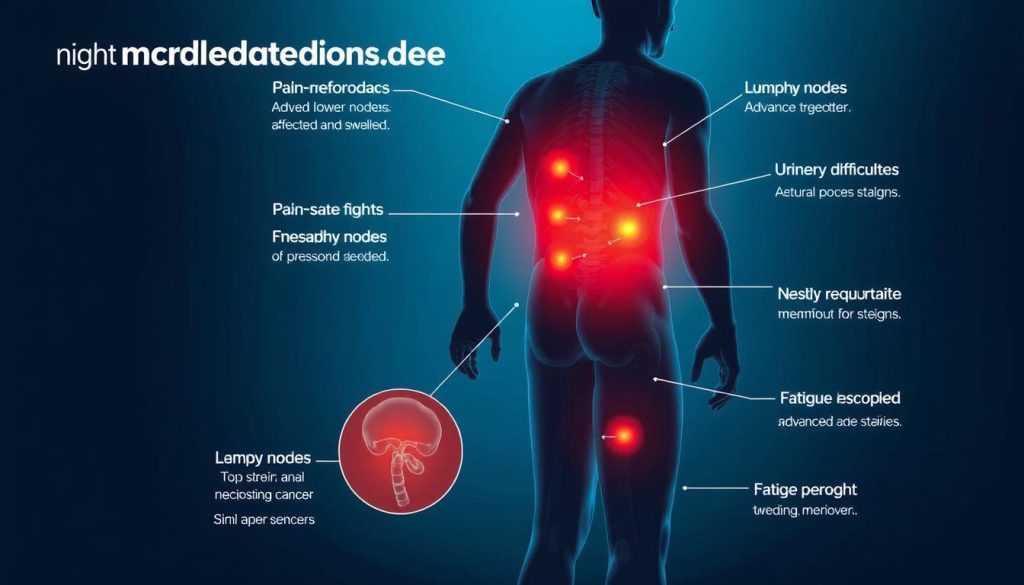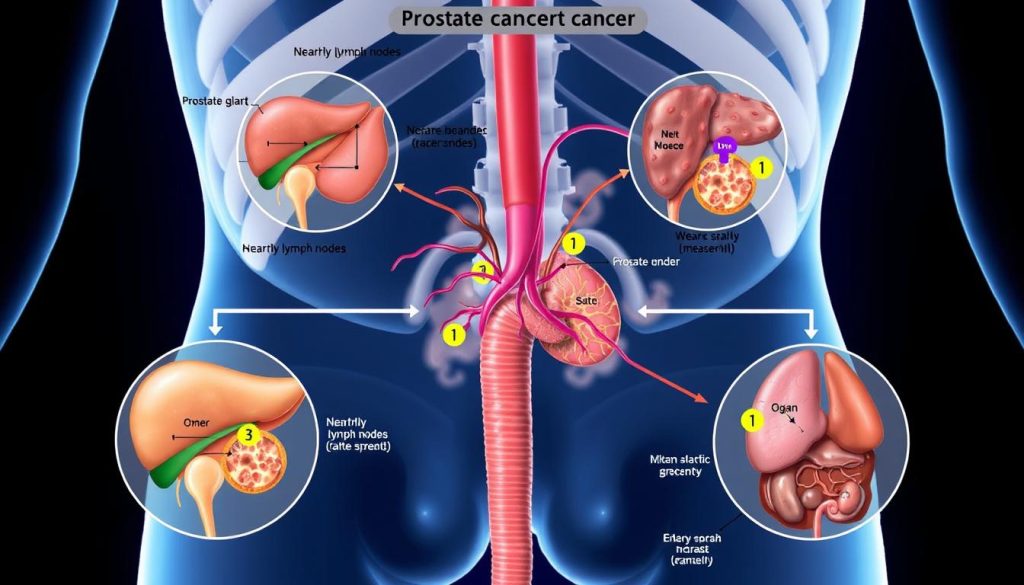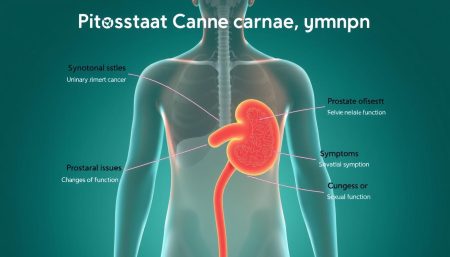Prostate cancer metastasis is a key moment in the disease’s growth. When cancer cells escape their original place, they can travel and form new tumors elsewhere. This change turns localized prostate cancer into a more complex, advanced form.
It’s vital to understand how prostate cancer spreads. As cells move, they make treatment harder and affect the outlook. Knowing the signs and patterns helps patients get care quickly and doctors create better treatment plans.
Let’s look at how prostate cancer cells spread, where they often go, and what it means for those diagnosed. This knowledge is key to understanding metastatic prostate cancer and how to manage it.
The Nature of Prostate Cancer Metastasis
Prostate cancer metastasis is a complex process. It greatly affects how we stage and predict the outcome of prostate cancer. Knowing how cancer cells spread is key to treating and managing the disease.
How Cancer Cells Break Away from the Prostate
Cancer cells in the prostate can break away through a process called epithelial-mesenchymal transition. This change makes cells more mobile and invasive. It lets them move into the bloodstream or lymphatic system.
Common Pathways of Prostate Cancer Spread
Prostate cancer usually spreads in two main ways:
- Lymphatic system: Cancer cells move through lymph vessels to nearby lymph nodes
- Bloodstream: Tumor cells enter blood vessels and travel to distant organs
Factors Influencing Metastatic Progression
Several factors can influence how fast and likely prostate cancer will spread:
| Factor | Impact on Metastasis |
|---|---|
| Gleason Score | Higher scores mean more aggressive cancer with higher metastatic potential |
| PSA Levels | High PSA levels may suggest advanced or spreading cancer |
| Tumor Stage | Later stages of prostate cancer are more likely to spread |
| Genetic Mutations | Certain gene changes can help cancer cells spread and survive |
Watching these factors helps in staging prostate cancer and predicting its outcome. Regular PSA tests and imaging studies are crucial. They help track metastasis and guide treatment choices.
Can Prostate Cancer Spread to Other Parts of the Body
Prostate cancer can move beyond its starting point, a process called metastasis. Knowing how it spreads is key to handling advanced prostate cancer well.
Primary Sites of Prostate Cancer Metastasis
Prostate cancer usually goes to certain parts of the body when it spreads. The most common places are:
- Bones (especially the spine and pelvis)
- Lymph nodes
- Liver
- Lungs
These spots can change how symptoms show up and what treatments are best.
Timeline and Progression Patterns
How fast prostate cancer spreads can vary a lot. Several things can affect how it moves:
| Factor | Impact on Progression |
|---|---|
| Gleason Score | Higher scores mean it spreads faster |
| PSA Level | Fast PSA increases mean quicker spread |
| Age at Diagnosis | Younger men might see slower spread |
| Treatment Response | Good treatment can slow or stop spread |
Detecting Metastatic Spread Through Imaging
Doctors use different imaging methods to find cancer spread:
- Bone scans
- CT scans
- MRI scans
- PET scans
These tests help spot prostate cancer risk factors and help decide on treatments for advanced cases.

Spotting cancer early and keeping an eye on it is crucial. Patients should talk to their doctor about any new symptoms right away. This helps catch problems early.
Recognizing Advanced Prostate Cancer Symptoms
It’s vital to spot advanced prostate cancer symptoms early. This helps in getting treatment quickly. As cancer grows, men might see signs that show it has spread.

- Persistent bone pain, especially in the spine, hips, or ribs
- Unexplained weight loss and decreased appetite
- Fatigue and weakness
- Difficulty urinating or changes in urinary habits
- Blood in urine or semen
These symptoms can differ from one person to another. Some men with advanced prostate cancer might not notice any signs at first. Regular health checks and screenings are key to catching problems early.
“Early detection of advanced prostate cancer can significantly impact treatment outcomes and quality of life.”
If you see any symptoms that worry you, see your doctor right away. They can run tests to see how you’re doing and what to do next. Taking care of your health is crucial in fighting prostate cancer.
Treatment Options for Metastatic Prostate Cancer
Patients with advanced prostate cancer have many treatment options to choose from. Hormone therapy is often the first choice. It lowers testosterone, which helps slow cancer growth.
Chemotherapy is another option for those with metastatic prostate cancer. Drugs like docetaxel and cabazitaxel target fast-growing cancer cells. Though side effects can be tough, these drugs can help patients live longer and feel better.
New treatments offer hope for advanced prostate cancer. Immunotherapy uses the body’s immune system to fight cancer. Targeted therapies, like PARP inhibitors, are promising for certain genetic mutations. These new methods aim to better treat prostate cancer and improve patient outcomes.
Creating a personalized treatment plan is key for metastatic prostate cancer. Doctors look at the cancer stage, overall health, and patient preferences. By mixing different treatments and watching progress closely, healthcare teams aim to improve life quality and extend life for those with advanced prostate cancer.
FAQ
Q: What is prostate cancer metastasis?
A: Prostate cancer metastasis happens when cancer cells break away from the prostate. They then spread to other parts of the body through the blood or lymphatic system. This marks the cancer as advanced, changing treatment options and outlook.
Q: How does prostate cancer spread?
A: Cancer cells detach from the prostate and enter the bloodstream or lymphatic system. They then travel to other organs. Common places include nearby lymph nodes, bones, liver, and lungs. The cancer’s aggressiveness, PSA levels, and overall health play a role in how it spreads.
Q: What are the primary sites of prostate cancer metastasis?
A: The most common places for prostate cancer to spread are the bones, especially the spine, pelvis, and ribs. It also often goes to lymph nodes, lungs, and liver. Less often, it can reach the brain and other organs.
Q: How is metastatic spread detected?
A: Imaging techniques like bone scans, CT scans, MRI, and PET scans detect metastatic spread. These methods show where cancer cells have spread. Regular PSA level checks also help spot potential metastasis.
Q: What are the symptoms of advanced prostate cancer?
A: Symptoms of advanced prostate cancer include bone pain, especially in the spine, hips, or ribs. Other signs are unexplained weight loss, fatigue, trouble urinating, or blood in the urine. Neurological symptoms can occur if it spreads to the brain or spinal cord. But, early stages might not show symptoms.
Q: What treatment options are available for metastatic prostate cancer?
A: Treatments for metastatic prostate cancer include hormone therapy, chemotherapy, immunotherapy, targeted therapies, and radiation therapy. The right treatment depends on how far the cancer has spread, its characteristics, and the patient’s health. Clinical trials for new treatments might also be an option.
Q: Can prostate cancer metastasis be prevented?
A: While preventing metastasis is not always possible, early detection and treatment can reduce the risk. Regular screenings, a healthy lifestyle, and addressing prostate symptoms promptly can help. These actions can lead to better outcomes and possibly prevent or delay metastasis.
Q: How does prostate cancer staging relate to metastasis?
A: Staging prostate cancer helps find out if it has spread and how far. Stages 1 and 2 mean the cancer is still in the prostate. Stages 3 and 4 indicate local spread or distant metastasis. The staging process is key for choosing the best treatment.


















